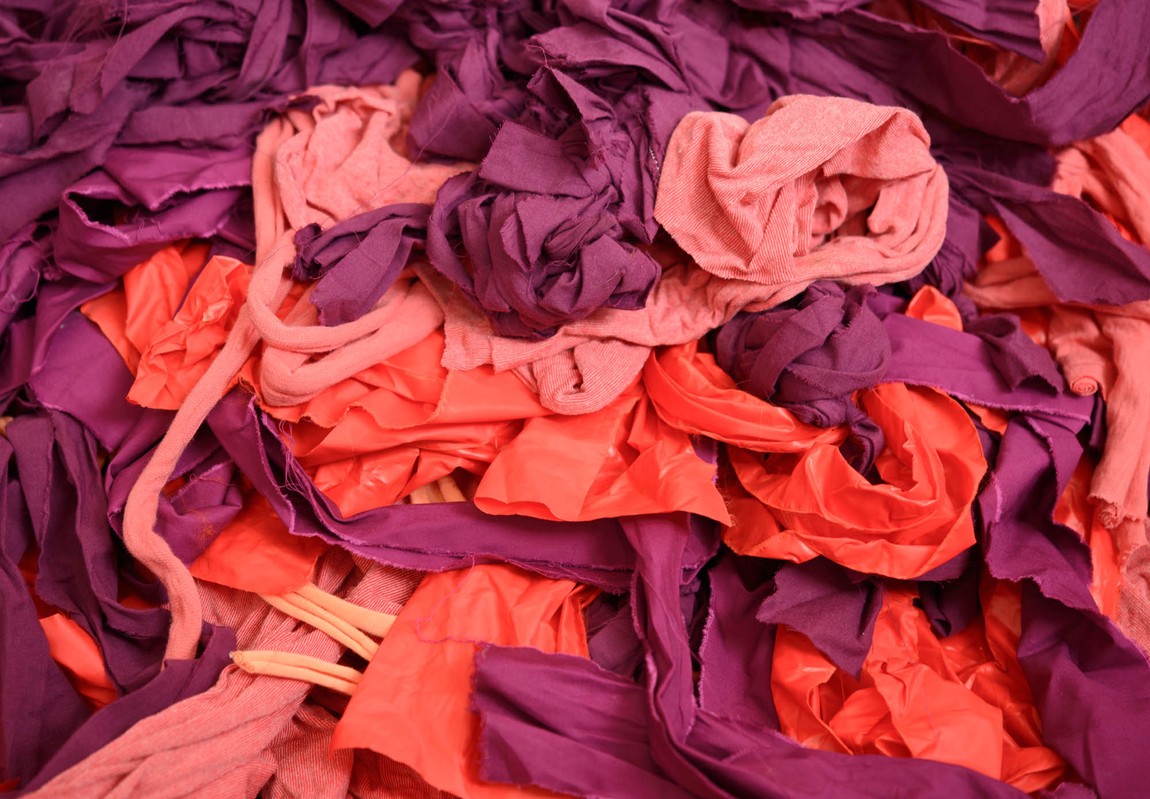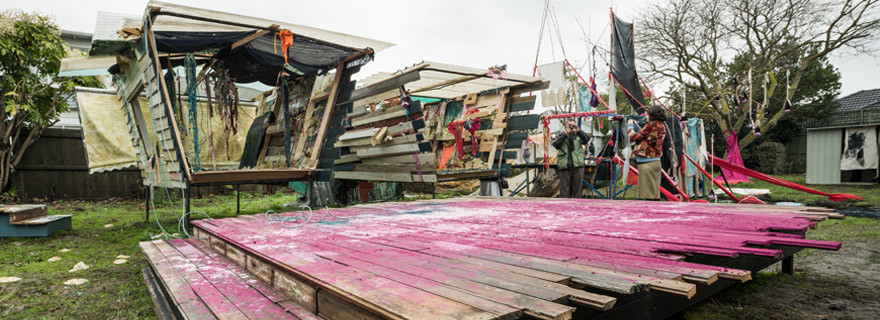
Sian Torrington
Wellington-based artist Sian Torrington is currently working with the Gallery on a site-specific sculptural installation for Christchurch. She talks with curator Felicity Milburn about that project, her process, and about the residency she recently undertook in Samoa.
Felicity Milburn: Many of your previous installations, such as Soft is Stronger than Hard (exhibited in The Obstinate Object at City Gallery Wellington in 2012), have had a deliberately adaptive, unstable and provisional quality, actively responding to, and drawing upon, the spaces and architecture around them. Adaptation and provisionality, of course, are especially relevant for Christchurch at this moment—is that one reason you are keen to make a project here?
Sian Torrington: 'When I look at your work it makes me think about how sometimes life is so chaotic and mixed up and your work is like that but it's beautiful too and it makes me feel really reassured.' That's a comment from an eighteen-year old in response to Soft is Stronger than Hard. Along with the images my Christchurch-based sister has been sending me of the sites that now occupy the central city, it made me begin to consider this project. It is easy to think that art is not the most important thing at a time like this, but when I visited Christchurch and saw Michael Parekowhai's incredible installation, I felt the powerful need for art in the community.
When I met with you in Wellington you said 'We've forgotten how it feels to be stable'. You were talking about buildings, but when taken as a sentence it also talks about us, our response to the huge losses that have occurred in Christchurch. My work stands up for itself on spindly, unlikely, indeed provisional legs, but it still stands up. It has the ability to fit in anywhere, to find a handhold and begin to grow, to respond, raise a flag, reach across gaps with the humblest of materials. This is what I hope to be able to draw and build in Christchurch.
I always look for the 'gaps' in structures that appear sealed, upright, decided firmly upon. I have researched abandoned buildings for projects, looking at the idea that once a building is no longer fit for its intended use, it becomes open as a metaphor or starting point for a new form. Georges Perec writes that we should change the pictures in our homes constantly so that they do not become invisible. I think this is also true of our cities; we become so used to our urban environment that we no longer perceive it as a present, conscious collection of metaphors relating to our physical existence in these buildings, our bodies. In Christchurch this comfort in the known environment has been violently interrupted, and this provides openings for the kind of sculptural metaphorical language I am interested in.
FM: You've worked with a range of media—sculptures made from found materials, small and large-scale drawings and also text. Do you find that certain ideas lend themselves to particular approaches, or do all of these elements contribute to a multi-layered whole?
ST: I joke that I always need to work on eight things at once, but it's true. I tend to work across a range of media, and I think this approach is partly about not getting stuck in one area and overworking things. My work has a gestural and energetic quality that is easy to lose if I look too hard at one part—it's always a fine balance and I find I will move between media to find the next step to take. Often words and language can show me what I need to draw, or sculpture can lead to poetry. I see the process as a form of excavation where different tools are needed to keep sparking what is discovered.
My poetry and writing comes alongside the making; I always have paper at hand to note down thoughts, found phrases or conversations. These become an authentic documentation of the process of making that may create titles or text to accompany the work. The small sculptures I see as condensed versions of the larger installation work. My materials have a patina which they acquire from being used more than once, finding many forms and eventually being condensed down to a smaller form where they rest.
FM: Your Christchurch project will encompass a number of stages—the collection of materials and ideas about the city, the development of these into sculptural elements and the presentation of the installation in a city location—and many of these will involve the participation of others. What does this collaborative aspect bring to your work that would otherwise be missing?
ST: I think that without community collaboration this project could not be authentic. I live in Wellington and I need to connect with the experiences people want to share in order to find the right language and approach. In terms of materials, it seems crazy to buy or bring materials when so much is available in the city, and I want to feel that the materials come from this place and this time.
I recently collaborated with Joan Fleming and Rachel O'Neill on a project for Blue Oyster Gallery in Dunedin, Caves are made of rock but not this cave. Joan is based in Dunedin and so was able to send me descriptions of the underground gallery space, which was a key part of the proposal. It was a new experience for me to invite others into my usually very private making process, and I found the way I was moved, challenged and supported in the conversations we had incredibly enriching. The work became something none of us could have anticipated or made alone. In terms of this project, I see myself as a kind of crucible through which fragments of experiences, photographs and conversations can be forged into something new; I'm excited to find people to begin talking with.
FM: You recently spent five weeks in Samoa as the result of a scholarship, which included running drawing workshops for teenagers, deaf students and the general public at the Tiapapata Art Centre, near Apia. Did this experience affect how you view your own practice?
ST: The effects of this experience have been deep and various and I am still processing what it has meant and done for my practice. I wrote a huge amount and made new drawings there, but mainly I want to develop new performance pieces from my experiences. The workshops I taught were very much based in my own work, including blind and experimental approaches to drawing, which I would like to develop as part of my teaching. I was very excited to go and spend time on a Pacific island, which is so much a part of what Aotearoa is, and also displace myself from my comfort zone of studio practice. The experience gave me rich ground to investigate my whiteness, my ideas of community, my queerness, as well as my sense of time, action and displacement.
I was also there just before the cyclone hit, which made me feel like an extremely privileged, wealthy white person in ways I had never felt before. I was able to escape, to jump on a plane, while a woman who lived nearby had no tarpaulins to cover holes in her home or protect her precious second-hand book collection. It made me feel helpless and over privileged in the same moment, and I have much to write, make and say about this experience. I am currently involved in some fund-raising projects in Wellington, which will include performance work developed from the residency.



Sian Torrington's installation will be presented from late May 2013 in a central Christchurch location. See the website for updated information and related blogs.








